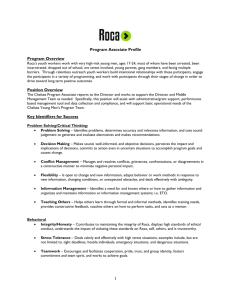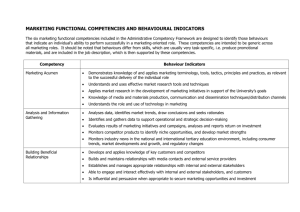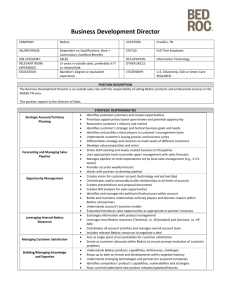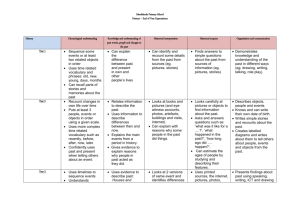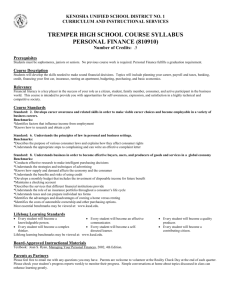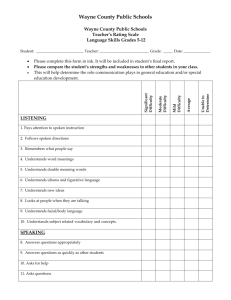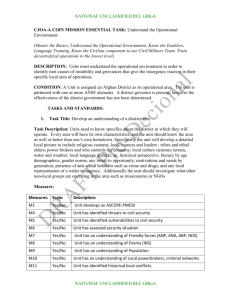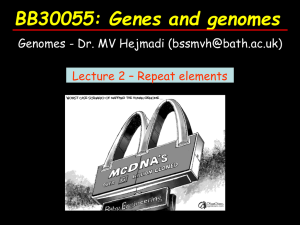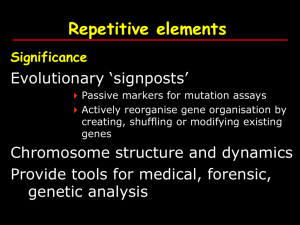Cognition Checklist
advertisement
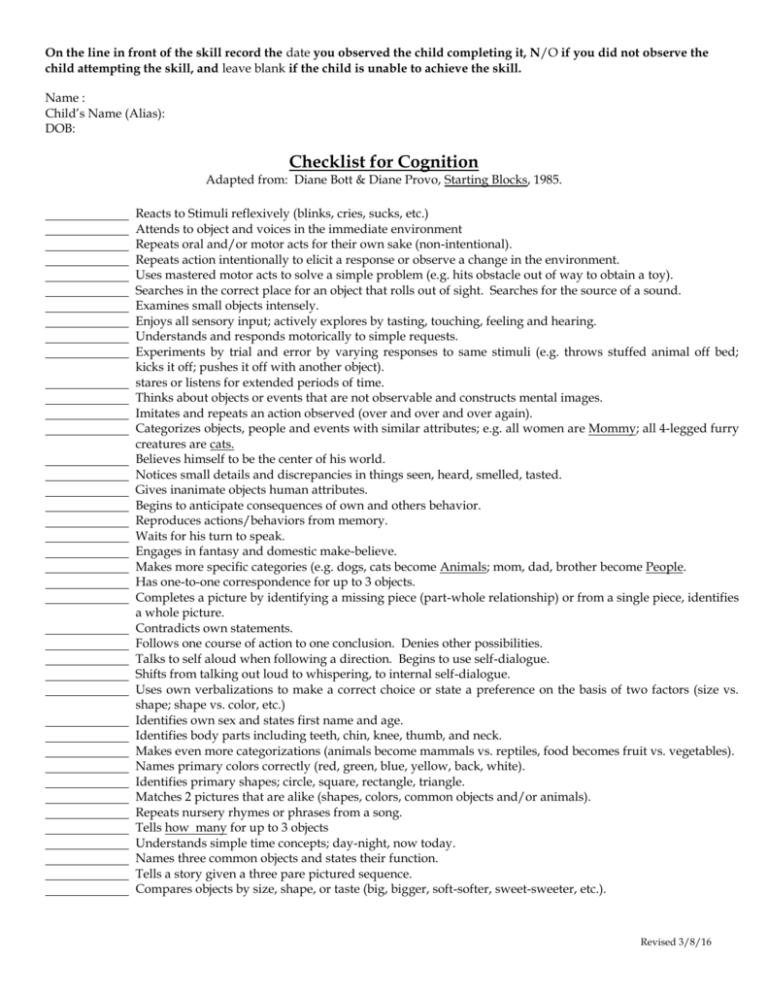
On the line in front of the skill record the date you observed the child completing it, N/O if you did not observe the child attempting the skill, and leave blank if the child is unable to achieve the skill. Name : Child’s Name (Alias): DOB: Checklist for Cognition Adapted from: Diane Bott & Diane Provo, Starting Blocks, 1985. Reacts to Stimuli reflexively (blinks, cries, sucks, etc.) Attends to object and voices in the immediate environment Repeats oral and/or motor acts for their own sake (non-intentional). Repeats action intentionally to elicit a response or observe a change in the environment. Uses mastered motor acts to solve a simple problem (e.g. hits obstacle out of way to obtain a toy). Searches in the correct place for an object that rolls out of sight. Searches for the source of a sound. Examines small objects intensely. Enjoys all sensory input; actively explores by tasting, touching, feeling and hearing. Understands and responds motorically to simple requests. Experiments by trial and error by varying responses to same stimuli (e.g. throws stuffed animal off bed; kicks it off; pushes it off with another object). stares or listens for extended periods of time. Thinks about objects or events that are not observable and constructs mental images. Imitates and repeats an action observed (over and over and over again). Categorizes objects, people and events with similar attributes; e.g. all women are Mommy; all 4-legged furry creatures are cats. Believes himself to be the center of his world. Notices small details and discrepancies in things seen, heard, smelled, tasted. Gives inanimate objects human attributes. Begins to anticipate consequences of own and others behavior. Reproduces actions/behaviors from memory. Waits for his turn to speak. Engages in fantasy and domestic make-believe. Makes more specific categories (e.g. dogs, cats become Animals; mom, dad, brother become People. Has one-to-one correspondence for up to 3 objects. Completes a picture by identifying a missing piece (part-whole relationship) or from a single piece, identifies a whole picture. Contradicts own statements. Follows one course of action to one conclusion. Denies other possibilities. Talks to self aloud when following a direction. Begins to use self-dialogue. Shifts from talking out loud to whispering, to internal self-dialogue. Uses own verbalizations to make a correct choice or state a preference on the basis of two factors (size vs. shape; shape vs. color, etc.) Identifies own sex and states first name and age. Identifies body parts including teeth, chin, knee, thumb, and neck. Makes even more categorizations (animals become mammals vs. reptiles, food becomes fruit vs. vegetables). Names primary colors correctly (red, green, blue, yellow, back, white). Identifies primary shapes; circle, square, rectangle, triangle. Matches 2 pictures that are alike (shapes, colors, common objects and/or animals). Repeats nursery rhymes or phrases from a song. Tells how many for up to 3 objects Understands simple time concepts; day-night, now today. Names three common objects and states their function. Tells a story given a three pare pictured sequence. Compares objects by size, shape, or taste (big, bigger, soft-softer, sweet-sweeter, etc.). Revised 3/8/16 Understand spatial and directional prepositions such as; on top, under, inside, by between, in front of. Also understands opposites such as; hot-cold, off-on, up-down, in-out, front-back, clean-dirty. Carries out 4 or more directions in correct sequence. Answers simple “wh” questions (What?, Where?, Who?, When?). Completes a simple analogy such as, (ice is cold, fire is _____.”, “As red as a _______.”). States what objects are made out of (wood, metal, paper, plastic). Understands situation that have occurred (past) and will occur (future). Retells from memory a simple story with a beginning, middle, and end. Makes up own stories from pictures, interprets basic emotions; happy, sad, tired, hungry, sick. States cause/effect (what?, why?) when asked to comment on a specific situation. Separates fantasy from reality, if asked. States personal information including address and phone number and birthday. Names and identifies coins; pennies, nickel, dime, quarter. Counts up to 10; has one-to-one correspondence for up to 5 objects. Converses in a less self-centered fashion and a more social reciprocal way. Asks for explanations and motives of actions observed. Learns left from right.

